Cow Parsley: All about an Umbellifer
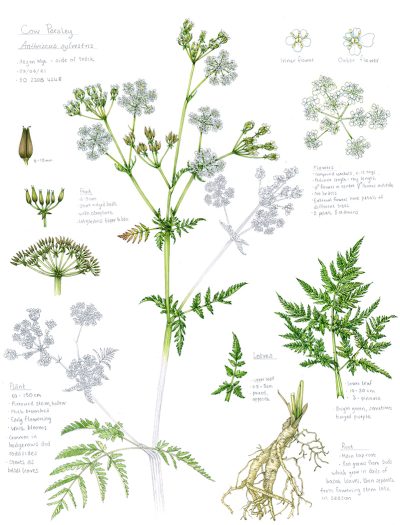
Cow parsley Anthriscus sylvestris was on the list of plants I recently illustrated for FOR Sweden. These plants are invasive in Scandinavia, and particularly troublesome in Iceland.
Sketchbook studies
All the botanical illustrations I do for FOR are in a sketchbook format. I love working this way; it gives me the opportunity to include tons of details alongside a larger illustration of the whole plant. Over the years I’ve figured out what elements I need to include for each plant, so can figure out the composition before getting started. In general, details of flowers, fruits seeds, roots, and a cross section of the stem is needed. These elements need to be accompanied by a habit sketch, a full colour image that shows the entire plant growing, and close ups of any unusual characteristics that the plant may have. I always include written notes, as much to jog my own memory as to help the viewer.

Cow Parsley Sketchbook study Anthriscus sylvestris
Another appealing thing about the sketchbook studies is that you can leave parts of the illustration unfinished. This gives me the opportunity to get into really intense detail on things like an individual leaf, or one bract. The pressure to have the entire drawing completed in full colour is gone, which makes the process more relaxing.
Cow Parsley in the spring
For those of you who have been in the British countryside in early June, you’ll already know all about the Cow parsley. If frothes up along hedgerows, spilling tiny white flowers out into rarely-used roads and paths. At the same time, the May blossom is out, so you often have the wonderful sight of lots of white blossom curving down from the shrubs and trees, being met by the Cow parsley flowers growing upward from margins of fields and lanes. It’s very beautiful.

Drawing the Cow Parsley
Umbellifers, like Cow parsley, are a real challenge to draw. I’m sure I’ve moaned about the challenges before in blogs on Hogweeds. The problem is that the plant is often really tall and leaves spread widely from the stem. However, each element of the plant is tiny. The flowering heads are made from hundreds of tiny individual flowers. the outermost ones are zygomorphic, meaning their outermost petals are a different shape to those of the internal flowers. The leaves are divided, or pinnate. Sometimes divided several times over, as with the Cow parsley. This results in very beautiful and feathery leaves. But combining the size with the detail is very difficult, hence my aversion to all members of the Apiaceae (or Umbelliferae) family. I love the way they look. I live in fear of being asked to illustrate them!
This commission came in at the height of Cow parsley season. I spent a morning gathering perfect plants, taking photos, and considering the best approach to the illustration. Once home, I pinned an entire plant up against the trampoline in the garden, with a sheet behind. I always take photos at the same time, sadly plants don’t live forever and some wither within hours of being picked.
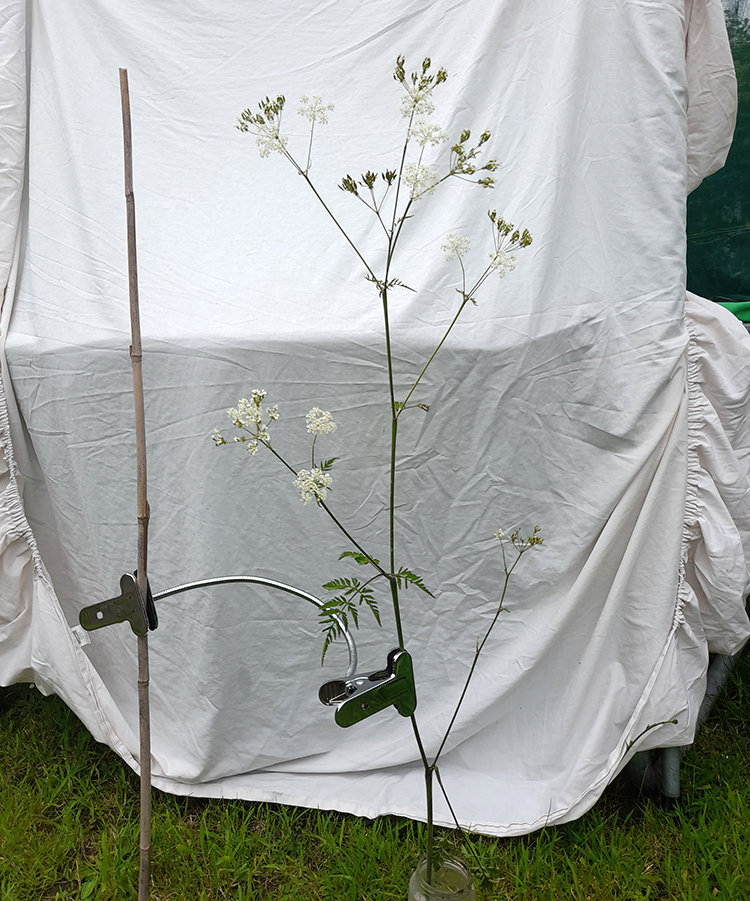
Cow parsley set up to draw in the garden
Cow Parsley: Flowering times and leaves
Identifying Cow parsley is easy, mainly because of when it flowers. It’s the earliest of these white-flowered umbellifers to bloom, especially in the southern UK. And it’s certainly the most common. Look for it from early April through June; by July all you’ll see is some basal leaf rosettes and seed-heads.
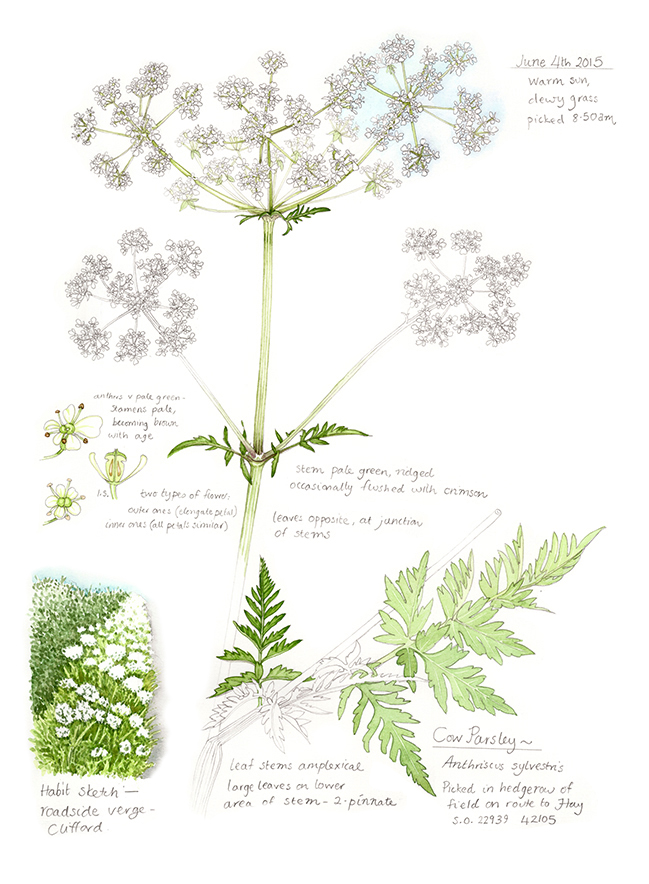
Cow parsley sketchbook study done back in 2015
The leaves set the plant apart from other common and similar species, such as Hogweeds. They are 2-3 pinnate, which means they’re divided into leaflets, then each of these leaflets is sub divided. It gives them a feathery, fern-like appearance. They tend to be a muted spring green, although can be tinged red or yellow when stressed by drought.
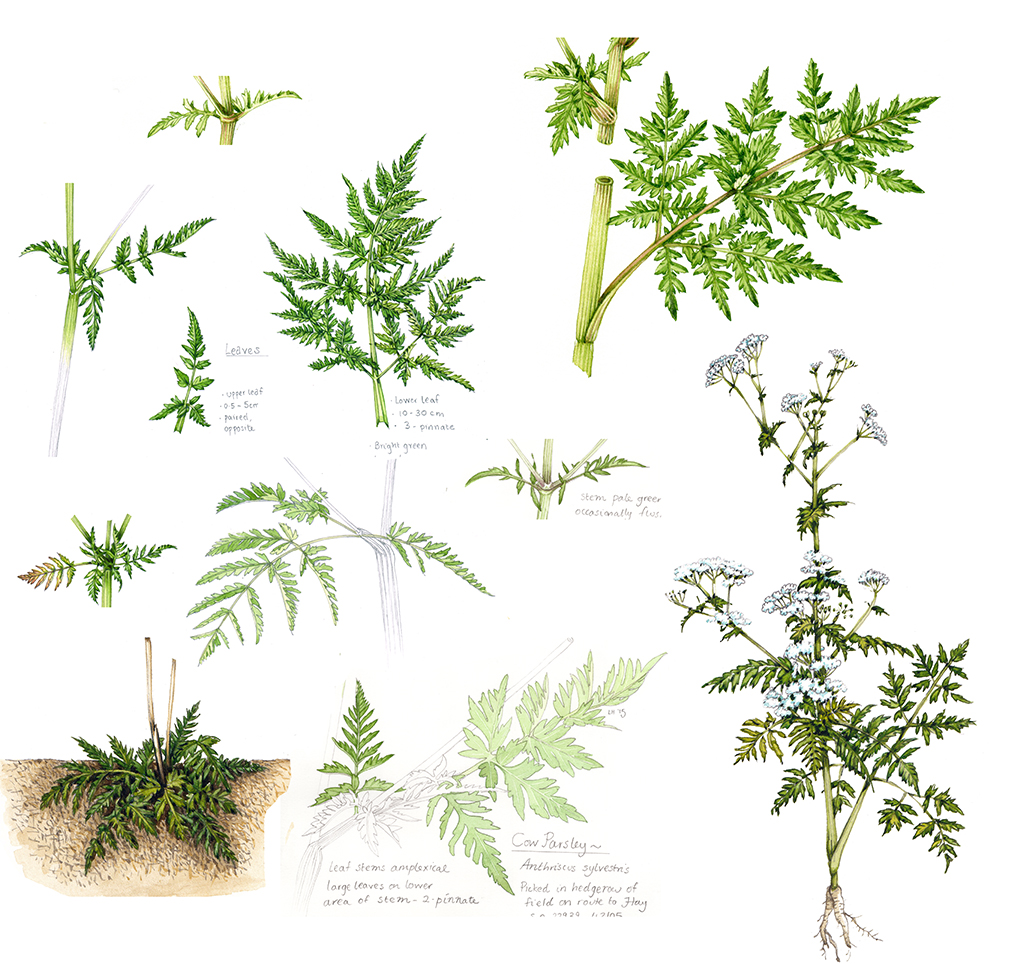
Cow parsley leaf variety and plant overview to show difference between small upper and large lower leaves
Leaves either grow from a basal rosette at the bottom of the plant, or alternately up the stem. Lower leaves are borne on long, broad stalks, higher up the plant the leaves have far shorter and thinner petioles. The big basal leaves can be up to 30cm, with individual divided lobes measuring 10 – 30mm
Cow parsley: Stems
Stems are gently ridged, and hollow. They don’t have blotches of colour like some other Apiaceae species. The stems can grow from 50 – 150cm, making this quite a tall plant. Stems tend to be slightly downy at the top, and hairless down by the base of the plant.
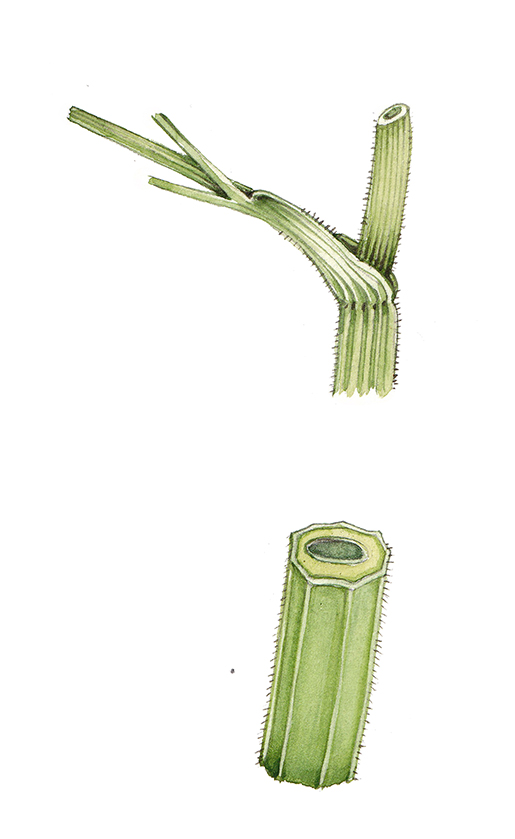
Cow parsley stems
Cow parsley: Flowers
The frothy flowering heads of this plant family are umbels; these are lots of little groups of flowers carried on stalks or rays. Each umbel has 6 – 12 of these rays which are about 2cm long. The arrangement of flowers has males in the centre and hermaphrodite flowers around the margins. Unless you’re inclined to get your hand lens out, this won’t be immediately obvious, although you’ll certainly see a difference in size between the inside and margin flowers.

Cow parsley flowers and detail of a small umbel seen from above
Each flower has 5 white petals and is 3 – 5 mm across. A whole umbel measures 10 – 60cm, but there’s plenty of variety.
There are no bracts right below the flowers, but some appear lower down. Sepals are there but are so tiny as to be inconspicuous. There are 5 stamen and 2 thin stigma.
The outermost flowers are zygomorphic which means their petals are of different sizes.
Cow parsley: Fruit
Fruit are 6-9mm long and carried in pairs. They start green and become brown at maturity. Each one has a short beak-like tip.
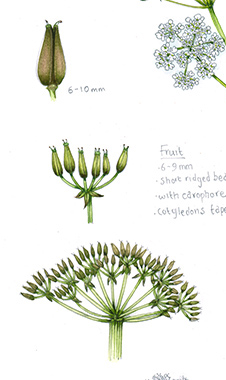
Cow parsley seeds
Conclusion
Why do I love Cow parsley so much? Well, it’s a combination of factors. The delicacy of the frond-like leaves is visually very pleasing. The mass of scented flowers smell of the countryside. And the way Cow parsley lines lanes and hedges is a harbinger of warmer days, and long golden hours spent revelling in an English summertime. So, for all of these reasons, and despite the issues with detail and scale, I’m happy to go on learning and drawing this gorgeous plant.
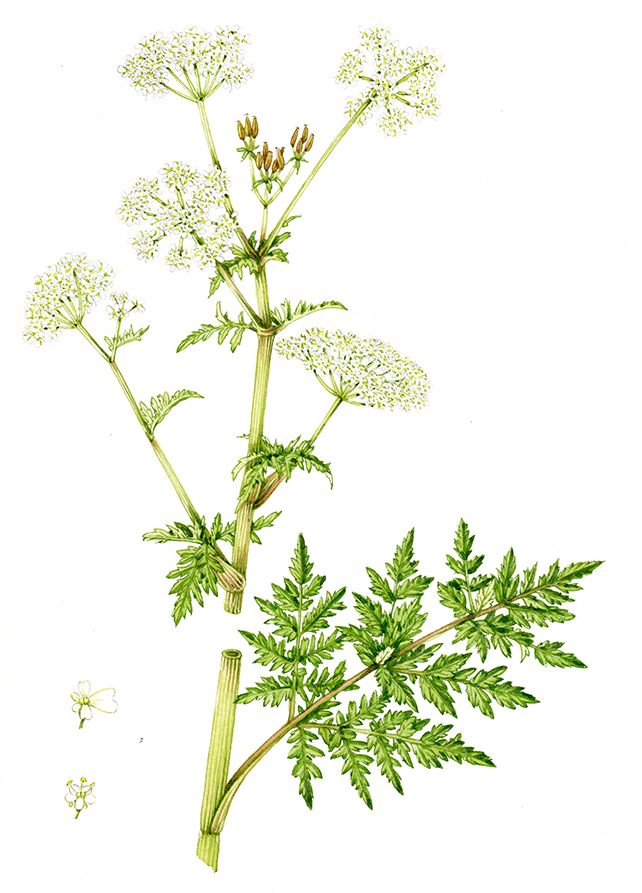
Illustration completed for FSC guide to Flowers of Walks & Waysides
Please see my step by step Youtube film below


I’d like to follow your blog, do you have a list I may join?
Hi Jean, good question. I dont have an RSS (I might mention it to my web designer, it’s a good idea!) but I publish blogs once a fortnight. they always pop up here: https://lizzieharper.co.uk/blogs/.
I do also have a newsletter that comes out 3 or 4 times a year; you can find it on my facebook page: https://www.facebook.com/LizzieHarperIllustration
Thanks jean
Lizzie
Lizzie, your blog must be broadcasting your posts to the aggregator sites because I get your posts from Feedburner. All it takes is an app to pick it up. I use Feedly on my laptop for all the blogs I follow.
Thanks Larry
Best designing, looking like a real umbel
Thanks
Good afternoon Lizzie
Once again a lovely blog post describing your process in a clear and precise manner so that I as a beginner can follow and make an attempt at but also allow the creation of my own style.
As an aside your greens are well mixed and very lifelike in there depth and tone please keep the posts or videos coming.
Regards
Peter
Hi Peter, what lovely feedback! Thanks so much!
Good evening Lizzie,
I wrote some 45 pages about Cow parsley for my herbalist course and would love to buy your illustration. I don’t suppose it’s possible? It’s really gorgeous. Do you sell it as a poster?
Chris Demeulemeester
Bruges, Belgium
Hi Chris
My goodness, 45pg on Cow parsley! And I thought I was seeing little white flowers in my sleep! Yes, I do have some original illustrations available, namely the sketchboiok study: https://lizzieharper.co.uk/product/cow-parsley-sketchbook-study-with-notes/. I think I may also have a smaller habit sketch available: https://lizzieharper.co.uk/product/habit-sketch-of-cow-parsley/ although I cant instantly lay hands on this. I think I may also have a full size print of another of my cow parsley illustrations (https://lizzieharper.co.uk/image/cow-parsley-anthriscus-sylvestris/) on sale for £50, but would need to check in the attic.
I could certainly get any one of these illustrations produced at a large size, which might work as a poster? The price would be something like £75, I’d imagine.
So good to meet a man who is so passionate (and well informed)e about such a wonderful plant!
Yours
Lizzie
Hi Lizzie
I am a woman (most herbalists are). A lot of Flemish Christianes, Christines and Christels like Chris better. I like the sketchbook study with notes. And in fact I’d prefer to buy the original watercolour. Could it be sent to Belgium?
Regards
Chris
Hi Chris
Thanks for this. Im very glad you like the cow parsley. It’s one of my favourites as well. Yes, of course it can be sent to Belgium. I’ll email you details now.
All the best
Lizzie
CUET (Common University Entrance Test) is to be conducted in online Computer Based Test (CBT) mode. In the CUET exam, there are a total of 4 sections in the exam where the first two sections are allotted to Subject-base; the last two will be Domain and General Test respectively. To understand this pattern of questions, you need to solve the CUET Previous Year Question Paper .
Here, The Bird And Evergreen Tree Emojis Merge To Create Unique New Emojis. After Generating A Combination, You Can Download The Image In PNG Format.
Your blog always does a great job covering local dining with clear and useful insights—really enjoy reading your recommendations! Anyone craving rich, flavorful crab dishes will find crab restaurants in houston tx to be a satisfying option.
This article explains the inspection process really well and makes compliance much easier to understand. I’ve read similar insights on other fleet and safety blogs, and many emphasize how accessible dot inspections near california can help operators stay prepared and avoid last-minute issues. Great information for anyone managing commercial vehicles in the region.
I’ve been reading several fleet safety and compliance blogs recently, and the way they explain inspection requirements, common violations, and preparation steps is extremely helpful for drivers and operators. Those clear breakdowns make it much easier to understand what inspectors look for and how regular checks can prevent costly issues. With insights like that available, finding reliable commercial truck dot inspection near me becomes far less confusing for anyone focused on staying compliant and road-ready.
Thanks for sharing such clear and helpful information. The clarity keeps readers engaged throughout. Anyone looking for more guides or topic expansions can check this site out to discover additional articles.
If you’re serious about wellness, this feels like the best cold plunge for home. Compact, efficient, and easy to maintain, it fits modern lifestyles while delivering real cold therapy benefits consistently and comfortably.